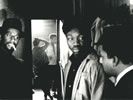Eye For Film >> Movies >> The Cool World (1964) Film Review
The Cool World is a film that takes a bit of getting used to. We open with a literally in your face close-up shot of a black preacher spreading the word that God is black, the Devil is white and that white Hell / Babylon is about to fall and black Heaven / Zion is at hand, on a street corner, white cops looking on at the assembled crowd, visibly suppressing their desire to go bust some heads.
Even beyond the preacher's message, one quite possibly challenging to even the hipper white viewers of the time, the sound and image appear raw and unpolished, with characters speaking all at once like in real life or providing disembodied voice-off monologues and polyphonic commentary – think Jean-Luc Godard crossed with Robert Altman, avant la lettre and garde– in a way calculated to upset.

As we focus in on the central characters and get attuned to the film's distinctive jazz rhythms and stylings it soon becomes familiar (un-de-familiarised?) rather than distancing, however, bringing us into the lives and plights of the Harlem negro – I use the world deliberately, as that of the era – circa 1960.
The central character is Duke, wonderfully portrayed by Hampton Clanton. In his mid-teens, he has three overriding, intertwined, goals. First, to become the president of the Royal Pythons gang, replacing his older friend Blood, who has become a junkie, and rebuild the gang. Second, to acquire a gun rather than a flick knife, so that he may really be somebody and garner respect in the neighbourhood – a need, it must be noted, born of fear, that if Duke does not have a gun and a reputation then he is prey to those with these vital ghetto commodities. Third, to defeat the rival Wolves gang, with their enemy colours.
These limited aspirations and horizons are beautifully contrasted with Priest, the hustler Duke looks up to, helps and seeks to obtain a gun from, seemingly the master of his own universe but in trouble with the white mob who in turn define and confine him to Harlem; Duke's older brother, currently out of the ghetto attending college in the hope of making his way out of it permanently in the white man's world; and the Coolies, those kids who try to stay in school and out of gangs like the Pythons and Wolves and often only make themselves fair prey to them all as a result, being prone to shakedowns for their money or drafting when a gang needs more members for a rumble.
Duke's monologues, mostly focusing on his need to get moving and get the $50 he needs for the gun – itself almost a character, in the way that money is in Robert Bresson's later L'Argent, though Béla Balázs Die Abenteuer eines Zehnmarkscheines was there before both of them – have a beautifully obsessive quality to them, playing elegant improvisations on a theme like a jazz musician working around a standard of the repertoire.
Indeed, scored as much of it is to the music of Dizzy Gillespie, with his group also featuring Charlie Mingus and Art Taylor, jazz style improvisation becomes the central aspect of the film's aesthetic. Working with a tighter script than one might guess (a script co-written with Carl Lee, who plays Priest) Clarke would use hand-signals to indicate to her on- and off-camera performers when they were free to depart from it, using a zoom, dissolve, unexpected move, or improvising around the central written riff.
Though her method is thus different from Cassavetes, who preferred to improvise as a means of letting him and his collaborators find the appropriate idioms and nuances to use in the filming, the end result is much the same as Shadows: an emphasis on process rather than product, leading to a remarkable naturalism of performance where you really believe that you are there with these people, living in their world.
The difference here, of course, is that you, the relatively privileged viewer, escape from your two hour ghetto tour in a way that the characters themselves cannot. Yet, if you are physically unscathed, the mental shocks continue to reverberate long after and, remarkable for a film that is nearly 50 years old, into the present-day.
The key point here, perhaps because it is made so directly and non-didactically by the one white character in the cast, Priest's wife, is ironically somewhat contrary to the preacher's message at the start: we are all in Hell until we unite and fight against racism until it becomes literally nothing. The thing which keeps us apart is the pigment of the imagination, and most particularly the limitations to our imaginations and beings that 'race' imposed at the time and, to perhaps a lesser extent, still continues to do.
In this regard, it's worth closing on an upbeat note, that if the ending for Duke, Priest and the other inhabitants fixed within the film and the ghetto remains a bleak one, for several members of the cast like Lee, Clarence Williams III and Antonio Fargas – yes, Huggy Bear himself – it was to be more fortuitous.
A truly unmissable, unforgettable experience.
Reviewed on: 25 Jun 2008















